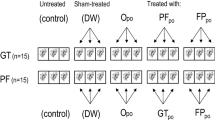Abstract
Preen glands exist in almost every bird species and several non-exclusive functions have been proposed for this gland and the oils that it produces. One function generally admitted is that the oily secretions of the preen gland would provide a waterproofing layer when spread over feathers. Alternatively, several authors have proposed that plumage waterproofness is mostly due to the spatial micro-structure of feathers. The purpose of this study was to examine, by manipulating the access to the preen gland, the effect of the preen oil on the plumage waterproofness and condition. To explore this question, we carried out two independent experiments where we temporarily blocked access to the preen gland secretions with a removable mechanism in one group of captive mallards (Anas platyrhynchos), whilst a second group of birds had access to gland secretions. In a long-term experiment (3 months of treatment) and a short-term experiment (10 days), we measured plumage water retention and condition. After 3 months without access to preen glands, we found a significant decrease of plumage condition and an associated increase in plumage water retention. Moreover, we found a significant correlation between plumage condition and water retention ability. In contrast, after 10 days of treatment, no significant effect was found on plumage condition and water retention. Our study shows that preen oil acts to maintain plumage condition and suggests that feather microstructure is essential to maintain plumage waterproofness.



Similar content being viewed by others
References
Borchelt PL, Eyer J, McHenry DS (1973) Dust bathing in Bobwhite quail (Colinus virginianus) as a function of dust deprivation. Behav Biol 8:109–114
Burtt EH, Ichida JM (1999) Occurrence of feather degrading bacilli in the plumage of birds. Auk 116:364–372
Elder WH (1954) The oil gland of birds. Wilson Bul 66:6–31
Haribal M, Dhondt A, Rodriguez E (2009) Diversity in chemical compositions of preen gland secretions of tropical birds. Bioch Syst Ecol 37:80–90
Hou H (1928) Studies on the glandula uropygialis of birds. Chin J Phys 2:345–380
Jacob J, Zisweiler V (1982) The uropygial gland. In: Farner DS, King JR, Parkes KC (eds) Avian biology (vol. 4). Academic Press, New York, pp 199–324
Joseph M (1891) Uber Schweiss und Talgdriisensekretion. Arch Anat Physiol 81-87
Lessells CM, Boag PT (1987) Unrepeatable repeatabilities: a common mistake. Auk 104:116–121
Lucas FS, Moureau B, Jourdie V, Heeb P (2005) Brood size modifications affect plumage bacterial assemblages of European starlings. Mol Ecol 14:639–646
Martín-Vivaldi M, Pena A, Peralta-Sanchez JM, Sanchez L, Ananou S, Ruiz-Rodriguez M, Soler JJ (2010) Antimicrobial chemicals in hoopoe preen secretions are produced by symbiotic bacteria. Proc R Soc Lond B Biol Sci 277:123–130
Moller AP, Czirjak GA, Heeb P (2009) Feather micro-organisms and uropygial antimicrobial defences in a colonial passerine bird. Funct Ecol 23(6):1097–1102
Moyer BR, Rock AN, Clayton DH (2003) An experimental test of the importance of preen oil in rock doves (Columba livia). Auk 120:490–496
Omland KE (1996) Female mallard mating preferences for multiple male ornaments. I. Natural variation. Behav Ecol Sociobiol 39:353–360
Reneerkens J (2007) Functional aspects of seasonal variation in preen wax composition of sandpipers (Scolopacidae). University of Groningen, Groningen, PhD dissertation
Rijke AM (1970) Wettability and phylogenetic development of feather structure in waterbirds. J Exp Biol 52:469–479
Ruiz-Rodriguez M, Valdivia E, Soler JJ, Martin-Vivaldi M, Martin-Platero AM, Martinez-Bueno M (2009) Symbiotic bacteria living in the hoopoe’s uropygial gland prevent feather degradation. J Exp Biol 212:3621–3626
Rutschke E (1960) Untersuchungen über Wasserfestigkeit und Struktur des Gefieders von Schwimmvögeln. Zoologische Jahrbüche 87:441–506
Shawkey MD, Pillai SR, Hill GE (2003) Chemical warfare? Effect of uropygial oil on feather-degrading bacteria. J Avian Biol 34:345–349
Sokal RR, Rohlf FJ (1995) Biometry, 3rd edn. Freeman, New-York
Tamisier A, Dehorter O (1999) Camargue, canards et foulques. Centre Ornithologique du Gard, Nımes
Van Rhijn JG (1977) Processes in feathers caused by bathing in water. Ardea 65:126–147
Acknowledgments
This project was supported by a French research grant (ANR-05, NT05-3_42075) to P. Heeb. We thank four referees for comments on previous versions.
Author information
Authors and Affiliations
Corresponding author
Electronic supplementary material
Below is the link to the electronic supplementary material.
ESM 1
(DOC 48 kb)
Rights and permissions
About this article
Cite this article
Giraudeau, M., Duval, C., Guillon, N. et al. Effects of access to preen gland secretions on mallard plumage. Naturwissenschaften 97, 577–581 (2010). https://doi.org/10.1007/s00114-010-0673-z
Received:
Revised:
Accepted:
Published:
Issue Date:
DOI: https://doi.org/10.1007/s00114-010-0673-z




